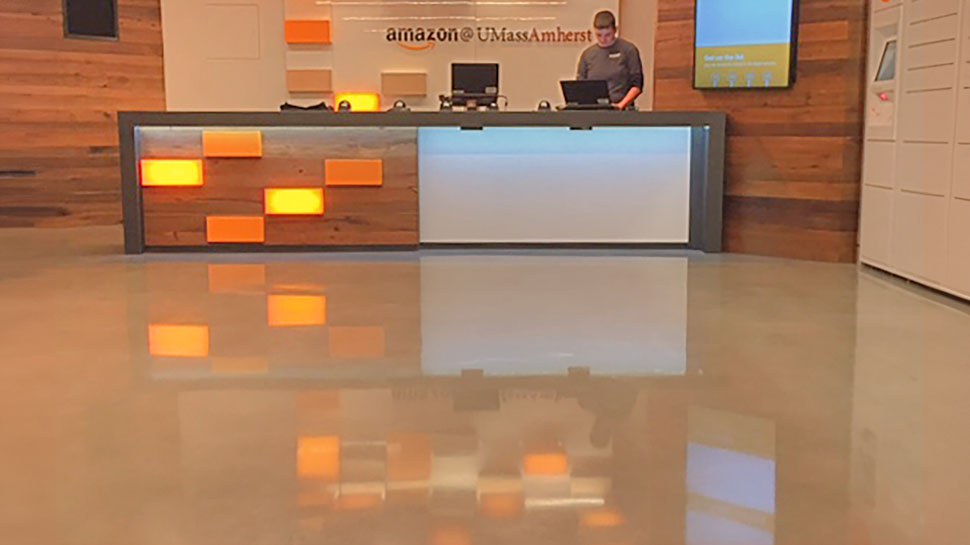
Even after tuition is paid, college is expensive. Textbooks and course materials, for example, are a major expense for most college students—costing the average student up to $1,225 a year. To help alleviate textbook costs, University of Massachusetts Amherst partnered with online retailer Amazon.com to offer a virtual bookstore expected to save individual students more than $350 annually in purchases. The online bookstore opened May 2015 and provides free, one-day shipping to campus addresses and nearby communities.
To support the collaboration, Amazon also opened an on-campus customer pick-up and drop-off location in June. The distribution center includes high-tech features like automated package pick-ups, in which students can open coded lockers to retrieve deliveries. Constructing the center involved converting a third-floor “textbook annex” into a facility worthy of Amazon’s brand.
A fast-track project
Tri-State Underlayments/Franz Floors Ltd. of Waterbury, Conn., only had four days to restore 1,200 square feet of the existing flooring before interior framing began. For this reason, the contractor chose to use Rapid Set® cement products to install the flooring, because they set quickly to produce 3000 psi in one hour and full strength (8000 psi) in one day. The completed facility will be subject to foot traffic in the ordering area and pallet jacking in the supply room.
“Using Rapid Set for the deep fill was key to a fast turnover,” says Scott Franz, owner of Tri-State Underlayments.
The contractor used 550 bags of Rapid Set Concrete Mix to place 3- to 5-inch infill slabs. The mix is a blend of hydraulic cement and quality aggregates that provides fast strength gain, low shrinkage and superior durability. The workable, multipurpose product sets in 15 minutes.
Addressing hot weather
The project took place in May—during 80- to 85-degree Fahrenheit temperatures—so Tri-State also faced the prospect of the concrete hardening too fast. The crew started every pour with 20 pounds of ice in water and two packets of Rapid Set SET Control® per bag. The additive helped slow down the setting time, giving the contractor more time to place and finish the concrete.
For increased flow control, the contractor also used 1.5 pouches of Rapid Set FLOW Control® for every four bags of pourable product. The additive significantly increased the fluidity of the mixture. Also, when used as a replacement for water, FLOW increases strength and reduces shrinkage. With FLOW, the same working consistency (or slump) may be produced with approximately 20% to 40% less mixing water.
The concrete was mixed and placed via a truck-mounted mixer pump to reach the third floor, pumping 100 bags an hour. The slabs were screeded and wet-cured.
Ready for coatings in 12 hours
Before Day 2 ended, the fast-setting concrete was ready for a primer. The contractor applied Rapid Set TXP™ Epoxy Primer, which seals porous concrete to prevent pinholes and installs floors quickly. The two-component formula is also low-VOC and moisture- and alkali-insensitive. Typically, a one-coat application of TXP offers high bond strength.
The contractor also broadcast 100% quartz silica sand to the point of refusal to ensure good adhesion with the floor topping. The excess sand was removed the following morning.
On Day 3, the crew applied Rapid Set TRU® Self-Leveling, which is an ideal product when producing a high-quality and fast floor topping. The one-component cement-based topping rapidly levels, maintains workability for 30 minutes and produces a smooth, strong surface with high bond strength. It is ready for foot traffic in two to three hours and for coatings in about 12 hours.
Plus, when applied at 12 mils (0.3 mm) thickness, the adhesion of TXP and TRU Self-Leveling will remain unaffected by moisture vapor transmission and alkalinity up to 14 pH. For this project, the contractor applied the topping at one-half-inch thickness (500 mils/12.7 mm).
The first 100 bags of TRU were mixed with 2% charcoal integral color and placed via the truck-mounted mixer pump. The last 30 bags were mixed by Hippo. The topping was then allowed to air dry.
Concrete polishing
The dry polishing process began on Day 4. Grinding machine operators started with 30/40-grit metal bonded diamonds and continued through 1,500-grit resin pads. For the final step, the contractor applied a stain guard and burnished it into the surface.
“I was very impressed with the hardness of TRU Self-Leveling, and the gloss level we were able to achieve when polishing,” says Franz.
The polished concrete floor complements Amazon’s contemporary and high-tech distribution center for college campuses, which is currently one of only three in the nation.